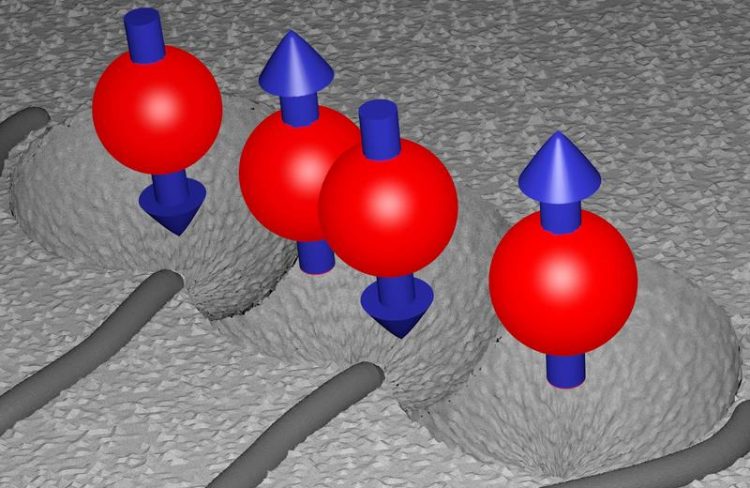Shielded quantum bits

Schematic representation of the new spin qubit consisting of four electrons (red) with their spins (blue) in their semiconductor environment (grey). Copyright: Maximilian Russ/Guido Burkard
The technological vision of building a quantum computer does not only depend on computer and information science. New insights in theoretical physics, too, are decisive for progress in the practical implementation. Every computer or communication device contains information embedded in physical systems.
“In the case of a quantum computer, we use spin qubits, for example, to realize information processing”, explains Professor Guido Burkard, who carries out his research in cooperation with colleagues from Princeton University. The theoretical findings that led to the current publication were largely made by the lead author of the study, doctoral researcher Maximilian Russ from the University of Konstanz.
In the quest for the quantum computer, spin qubits and their magnetic properties are the centre of attention. To use spins as memory in quantum technology, they must be lined up, because otherwise they cannot be controlled specifically.
“Usually magnets are controlled by magnetic fields – like a compass needle in the Earth’s magnetic field’, explains Guido Burkard. “In our case the particles are extremely small and the magnets very weak, which makes it really difficult to control them”. The physicists meet this challenge with electric fields and a procedure in which several electrons, in this case four, form a quantum bit.
Another problem they have to face is the electron spins, which are rather sensitive and fragile. Even in solid bodies of silicon they react to external interferences with electric or magnetic noise. The current study focuses on theoretical models and calculations of how the quantum bits can be shielded from this noise – an important contribution to basic research for a quantum computer: If this noise can be shielded for even the briefest of times, thousands of computer operations can be carried out in these fractions of a second – at least theoretically.
The next step for the physicists from Konstanz will now be to work with their experimental colleagues towards testing their theory in experiments. For the first time, four instead of three electrons will be used in these experiments, which could, e.g., be implemented by the research partners in Princeton.
While the Konstanz-based physicists provide the theoretical basis, the collaboration partners in the US perform the experimental part. This research is not the only reason why Konstanz is now on the map for qubit research. This autumn, for example, Konstanz attracted the internationally leading scientific community in this field for the “4th School and Conference on Based Quantum Information Processing”.
Key facts:
• Guido Burkard and his team of physicist at the University of Konstanz publish a theoretical concept to realize the processing of quantum information. The study was published in the current issue of the renowned journal “Physical Review Letters”.
• Link to the original publication:
https://journals.aps.org/prl/accepted/cf071Y52H8314171f2e801d42078646e42f9e53aa
DOI: https://doi.org/10.1103/PhysRevLett.121.177701
• In theoretical models and calculations the study shows how quantum bits can be shielded from magnetic and electronic noise. The new findings contribute to basic research for a quantum computer.
• Shielding the electric or magnetic noise results in an extended coherence time of spin qubits and thus provides the potential to carry out numerous computer operations.
• Konstanz research on spin qubits is carried out in collaboration with Princeton University. The new findings can now be tested in experiments.
• Further links:
https://www.uni-konstanz.de/spinqubits
https://theorie.physik.uni-konstanz.de/burkard/
http://pettagroup.princeton.edu/
Image:
https://cms.uni-konstanz.de/fileadmin/pi/fileserver/2018/Bilder/Geschuetzte_Quan…
Caption: Schematic representation of the new spin qubit consisting of four electrons (red) with their spins (blue) in their semiconductor environment (grey).
Copyright: Maximilian Russ/Guido Burkard
Contact
University of Konstanz
Communications and Marketing
Phone: + 49 7531 88-3603
E-Mail: kum@uni-konstanz.de
Media Contact
All latest news from the category: Physics and Astronomy
This area deals with the fundamental laws and building blocks of nature and how they interact, the properties and the behavior of matter, and research into space and time and their structures.
innovations-report provides in-depth reports and articles on subjects such as astrophysics, laser technologies, nuclear, quantum, particle and solid-state physics, nanotechnologies, planetary research and findings (Mars, Venus) and developments related to the Hubble Telescope.
Newest articles

Properties of new materials for microchips
… can now be measured well. Reseachers of Delft University of Technology demonstrated measuring performance properties of ultrathin silicon membranes. Making ever smaller and more powerful chips requires new ultrathin…

Floating solar’s potential
… to support sustainable development by addressing climate, water, and energy goals holistically. A new study published this week in Nature Energy raises the potential for floating solar photovoltaics (FPV)…

Skyrmions move at record speeds
… a step towards the computing of the future. An international research team led by scientists from the CNRS1 has discovered that the magnetic nanobubbles2 known as skyrmions can be…





















